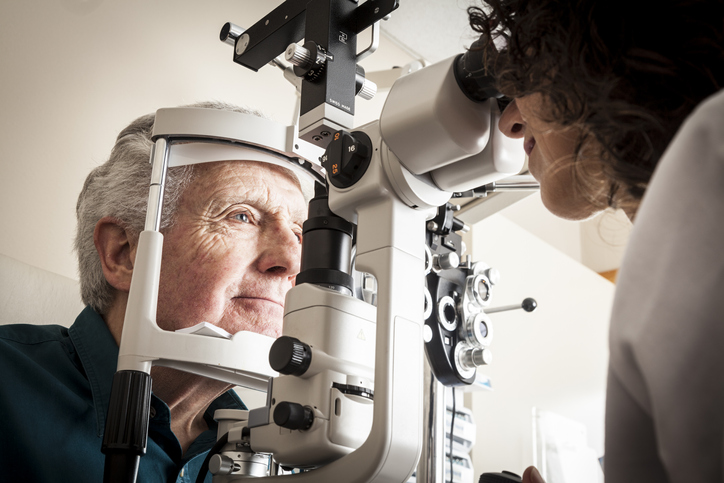Age-related macular degeneration (ARMD) is the leading cause of blindness in adults over the age of 60. As its name implies, the condition primarily affects the macula, which is the region of the retina responsible for central vision. A person whose macula is impacted by retinal disease may develop difficulty with tasks such as reading and driving, but maintain good peripheral vision.
If you have ARMD, understanding the signs and symptoms, proper monitoring, early detection of advancing disease, and timely treatment are all key to preserving vision.
Stages of age-related macular degeneration
ARMD may be classified as early, intermediate, or advanced, depending on physical changes visible to an ophthalmologist during an eye exam. Early ARMD is characterized by the presence of small yellow deposits known as drusen in the layer behind the retina. Drusen can be found in healthy eyes as people age, but when they become numerous, a diagnosis of ARMD may be made. Someone with early ARMD may not experience any visual symptoms, and is likely to have good visual function when measured using standard methods such as an eye chart.
When the number and size of drusen reach a certain threshold, ARMD is graded as intermediate, which carries a higher risk of progressing to advanced ARMD and vision loss. Those with intermediate ARMD may start to have early symptoms such as distortion in their central vision or mild loss of visual acuity, although this is not always the case.
A designation of advanced ARMD is made when patients develop either degenerative loss of photoreceptors (light-sensitive cells in the retina), referred to as atrophy, or abnormal blood vessel growth, referred to as choroidal neovascularization (CNV).
There are two main types of advanced ARMD: exudative (wet) ARMD and non-exudative (dry). The presence of CNV confers a designation of wet ARMD. All other forms of ARMD, including early, intermediate, and atrophy, are considered dry ARMD. Nearly every case of wet ARMD starts out as dry ARMD.
When advanced ARMD involves the fovea, which is the photoreceptor-rich center of the macula, patients can experience profound vision loss. Atrophy typically develops slowly over time, with vision loss occurring when it encroaches on the fovea. The effects of CNV, including accumulation of fluid or blood under or within the retina, may occur more rapidly and cause a sudden decline in vision.
Preserving vision in people with macular degeneration
The Age-Related Eye Disease Studies (AREDS and AREDS2) clinical trials found that taking antioxidants, lutein, and zeaxanthin at the studied doses reduced the risk of progression from intermediate to advanced stage ARMD by approximately 25%, thereby increasing the chances of preserving vision.
In people who do develop advanced ARMD, the availability of treatment options depends on whether they have the dry or wet form of the condition. There is no FDA-approved treatment for advanced dry ARMD. However, there are several therapies under investigation that may one day slow down or potentially reverse the changes that impact vision.
Conversely, wet ARMD has multiple FDA-approved and off-label agents proven to arrest and reverse the effects of CNV in the macula. The current standard of care is injection of anti-vascular endothelial growth factor (anti-VEGF) medications into the vitreous cavity of the eye (the gel-filled space that makes up most of the eyeball). Anti-VEGF drugs work by inhibiting the growth of abnormal new blood vessels. There are also several promising treatments in the pipeline for wet ARMD, including longer lasting anti-VEGF medications, combination medications, surgically implanted medication reservoirs, and gene therapy. There is also hope for eye drops or oral medications, although these therapies have a longer time horizon.
Reducing risk of progression and early detection of advanced ARMD are key
If you have ARMD, the best way to preserve vision is by reducing your risk of progressing to more advanced ARMD, and early detection of the treatable wet form. To start, smoking cessation and a healthy diet can reduce the risk of progression to advanced ARMD and prevent related vision loss. Your ophthalmologist will recommend AREDS2 vitamins, which are available over the counter without a prescription, to reduce the risk of further progression if you have been diagnosed with intermediate stage ARMD. He or she will also regularly check for signs of disease progression.
Be aware of the symptoms of progressing macular degeneration, including blurred or distorted central vision. And at the direction of your ophthalmologist, monitor your vision at home with an Amsler grid (a grid of horizontal and vertical lines used to monitor the central visual field) or other home monitoring device. More sophisticated home monitoring systems, including retinal scanning devices, are on the horizon. They may help detect wet ARMD so that it may be treated before permanent damage is done to the retina.
Current therapies can control the disease and preserve vision for years or longer, so early detection is key. Furthermore, regular follow-up visits with an ophthalmologist remain important, as he or she will check for evidence of disease progression that may not be apparent to you. Your ophthalmologist will also be most aware of new and emerging treatments in the rapidly evolving landscape of ARMD therapy.
The post Age-related macular degeneration: Early detection and timely treatment may help preserve vision appeared first on Harvard Health Blog.
, Age-related macular degeneration is the leading cause of blindness in people over 60. In order to preserve vision, it’s important to understand the stages of ARMD, its signs and symptoms, how the disease progresses, how to monitor it, and what treatments are available.
The post Age-related macular degeneration: Early detection and timely treatment may help preserve vision appeared first on Harvard Health Blog., Read More

